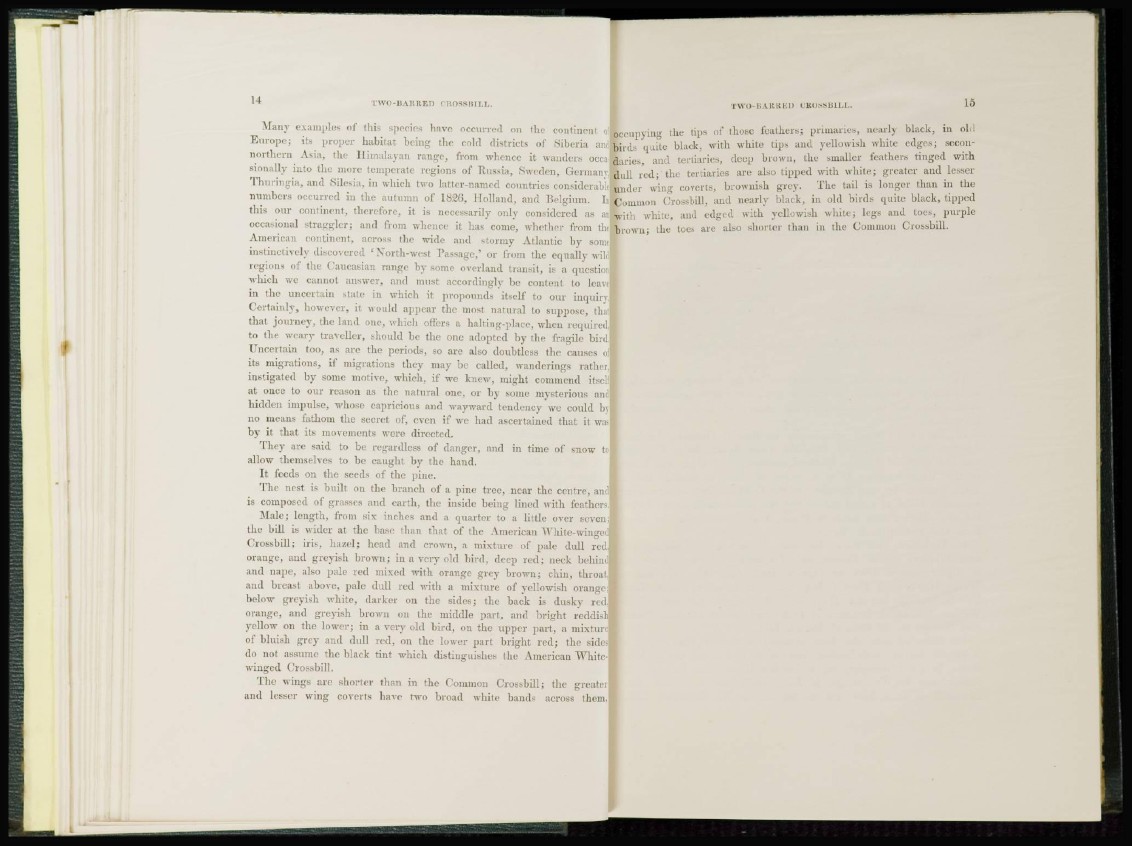
1 4 rWO-BARRED CROSSBILL. TWO-BAR R ED CBOSSB1L1 • 1 5
Many examples of this species have occurred on the continent of
E u r o p e ; its proper habitat being the cold districts of Siberia aw
n o r t h e r n Asia, the Himalayan range, from whence it wanders occasionally
into the more temperate regions of Russia, Sweden, Germany
T h u r i n g i a , and Silesia, in which two latter-named countries considerable
numbers occurred in t h e autumn of 182(>, Holland, and Belgium. Ii.
t h i s our continent, therefore, it is necessarily only considered as ar.
occasional s t r a g g l e r ; and from whence it has come, whether from th<
American continent, across the wide and stormy Atlantic by some
instinctively discovered ' North-west Passage,1 or from the equallv wild
regions of the Caucasian range by some overland transit, is a questioi
which we cannot answer, and must accordingly be content to leave
in the uncertain state in which it propounds itself to our inquiry
C e r t a i n l y , however, it woidd appear the most natural to suppose, thai
that j o u r n e y , the l a n d one, which offers a halting-place, when required,
to the weary traveller, should be the one adopted by the fragile bird
Uncertain too, as are the periods, so are also doubtless the causes of
its migrations, if migrations they may be called, wanderings rather,
i n s t i g a t e d by some motive, which, if we knew, might commend itseli
at once to our reason as the natural one, or by some mysterious am;
hidden impulse, whoso capricious and wayward tendency we could bj
no means fathom the secret of, even if wc had ascertained that it wat
b y it that its movements were directed.
They are said to be regardless of danger, and in time of snow t<
allow themselves to be caught by the hand.
I t feeds on the seeds of the pine.
The nest is built on the branch of a pine tree, near the c e n t r e , ane.
is composed of grasses and earth, the inside being lined with feathers,
Male; length, from six inches and a quarter to a little over seven;
t h e bill is wider at the base than that of t h e American White-Winged
C r o s s b i l l ; iris, hazel; head and crown, a mixture of pale dull red,
orange, and greyish brown; in a very old bird, deep r e d ; neck behind
and nape, also pale red mixed with orange grey brown; chin, throat,
a n d breast above, pale dull red with a mixture of yellowish orange,
below greyish white, darker on the sides; the back is dusky red,
orange, and greyish brown on the middle part, and bright reddish
yellow on the lower; in a very old b i r d , on the upper part, a mixture
of bluish grey and dull red, on the lower part bright red; the side;
do not assume the b l a c k tint which distinguishes the American Whifewinged
Crossbill.
T h e wings arc shorter than in the Common Crossbill; the greater
and lesser wing coverts have two broad white' bands across them,
becupying the tips of those feathers; primaries, nearly black, in old
i r d s quite black, with white tips and yellowish white edges; seconaries,
and tertiaries, deep brown, the smaller feathers tinged with
nil red; the tertiaries are also t i p p e d with white; greater and lesser
der wing coverts, brownish grey. The tail is longer than in the
ommon Crossbill, and nearly black, in old birds quite black, tipped
ith white, and edged with yellowish white; legs and toes, purple
"brown; the toes are also shorter than in the Common Crossbill.
• mi W I I I I ninnrai